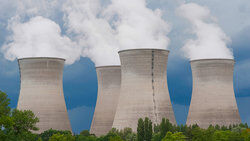
Nuclear energy might have your head swimming with images of a mushroom cloud. While nuclear weapons are one use of nuclear energy, there are several other uses that have both advantages and disadvantages. To learn more, explore examples of nuclear energy and how it is used.
What Is Nuclear Energy?
Nuclear energy comes down to atoms. When an atom splits or fuses together, it creates a reaction in the form of heat energy. While most of the focus is on the nuclear power created in these reactions, nuclear power and nuclear energy are different.
Nuclear power is created by harnessing the energy from the reaction. Nuclear energy is itself created during the reaction. Before you can look at how nuclear energy is used in your life, you need to look at the two types of nuclear energy.
Nuclear Fusion
When you think about nuclear fusion, think about things fusing together. Because that is what is happening. In nuclear fusion, atoms are fused or combined together to create energy. The sun is one of the best examples of nuclear fusion. Inside the sun, hydrogen nuclei fuse together to form helium, creating heat energy that warms the Earth.
Nuclear Fission
If nuclear fusion is when atoms fuse together, then you can probably guess that fission energy is created when the nucleus of an atom breaks apart. The fission reaction you might be the most familiar with is when uranium is used in nuclear power plants. Inside the reactor, the nucleus of the atom is forced apart, creating nuclear energy.
What Is Nuclear Energy Used For?
Nuclear energy and its byproducts, like cobalt-60, have several uses. These include not only in the creation of power and weapons, but also for medicine, space exploration and more. Explore these examples of nuclear energy uses.
Electricity
When you think of nuclear power, you’re thinking of how nuclear fission heat is used to generate electricity. This is done in a nuclear power plant, when uranium is split within a reactor. The energy created heats water to spin turbines. The spinning of the turbines produces electricity much like the turbines on windmills.
You can’t talk about nuclear power plants without a discussion of Chernobyl in 1986 and Fukushima Daiichi in 2011. In both of these incidents, the nuclear reactors melted down, causing radiation and nuclear waste to be released into the atmosphere. These accidents affected the lives of several thousand people and caused numerous deaths.
While nuclear power is generally reliable and less costly, the byproducts and water pollutants that it creates make it extremely controversial.
Nuclear Weapons
Another thing that comes to mind when you think about nuclear energy is weapons, like the atomic or hydrogen bomb. Using both nuclear fission and fusion, these bombs create a powerful explosion, which can demolish large areas in seconds. The explosion also creates toxic levels of radiation for those who survive the initial blast.
The magnitude of the devastation that these weapons could create in war make them highly regulated. In fact, an international treaty was created in 2017 by several major nations to prevent nuclear weapons from spreading.
Space Exploration
Nuclear energy can be used in generators for exploring deep space. The Cassini-Huygens probe explored Saturn with the use of a Radioactive Isotope Thermoelectric Generator (RTG) before being destroyed in 2017.
Nuclear Medicine
Some of the byproducts that are created during nuclear fission in reactors are important for areas of medicine. For example, cobalt-60 is used by hospitals to sanitize equipment like implants, catheters and scalpels, along with complex medical devices and other technology. It is also used in medical radiotherapy for cancer treatment and in medical imaging. Positron emission tomography (PET) scans use a special dye with radioactive tracers.
Food Treatments
Nuclear energy and technology are used within food and agriculture to make processes safer and more effective. For example, nuclear-related technologies are used in sterilizing agricultural pests to reduce the use of pesticides. This makes it impossible for the bugs to reproduce, gradually eliminating them.
Nuclear energy techniques are also used to test foods to ensure harmful contaminants aren’t lingering on products. These techniques can also improve yields from livestock.
Future of Nuclear Energy
Scientists are only beginning to understand the applications of nuclear energy in many areas of our lives. Additionally, given the availability of this non-renewable resource and its low carbon footprint, many experts believe that nuclear energy and nuclear power will be an important aspect of the future. Currently, nuclear power makes up 10% of the energy used around the globe.
The Complicated World of Nuclear Energy
Nuclear energy is a complicated and controversial subject. There are clear advantages and disadvantages of nuclear energy depending on what it is used for. The radiant energy from the sun warms the Earth, while nuclear weapons can create devastation. Looking at examples of nuclear energy uses can help you see its pros and cons. Curious about other forms of energy? Check out the exciting world of chemical energy.